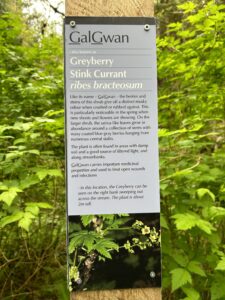in my field observations, I began to study a peculiar organism which is locally known as Gal Gwan also known as Greyberry Stink Currant ribes bracteosum. with their unique traits and attractive existence in Haida Gwaii’s different ecosystems, these strange species caught my interest. the three locations I choose as research sites are
- Coastal Wetlands – in these lust coastal wetlands, Gal Gwan ornamented the environment as they grow in nutrient rich, marshy soil. these have vibrant colors and complex designs which were eye catching and their abundance appeared as they are very close to water resources.
- Temperate Rainforest – when venturing in temperate rainforest, Gal Gwan sightings became less frequent as the thick canopy and tall trees created a different microclimate which affected the distribution of these organisms. the color of gal gwan also appeared to be more subdued there.
- Alpine Meadows – Gal Gwan sightings were sparse as we move to alpine meadows at higher levels. the harsher temperature and rocky terrain are proved to be less favorable for their presence and the color appeared to be different an the location.
with these observed patterns, i hypothesize that the distribution of Gal Gwan is strongly influenced by moisture levels, temperature, elevation along the environmental gradient.
i predict that abundance of Gal Gwan is highest in areas such as coastal wetlands where moisture and temperature is moderate.
response variable: Gal Gwan abundance – continuous
explanatory variable: Moisture levels in the substrate – continuous
The structure enables a quantitative study of the link between moisture levels and the abundance of Gal Gwan. The continuous character of these variables allows for a more detailed understanding of how environmental conditions impact the spread of these strange organisms.
